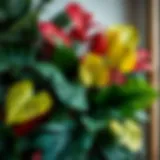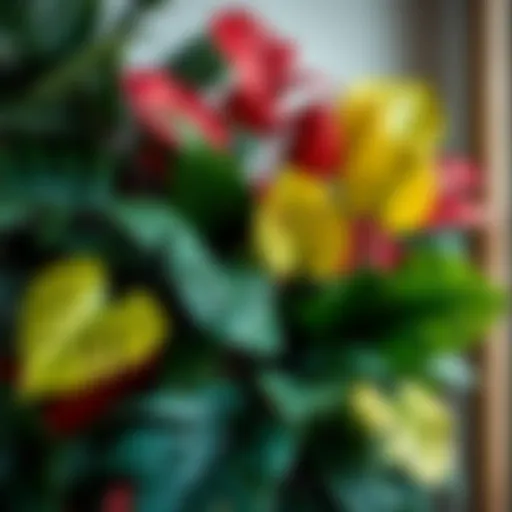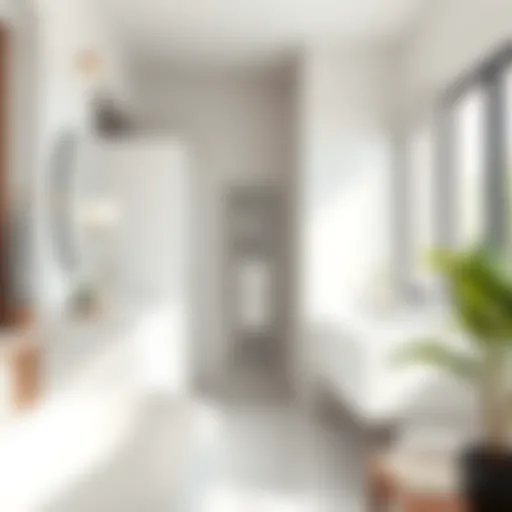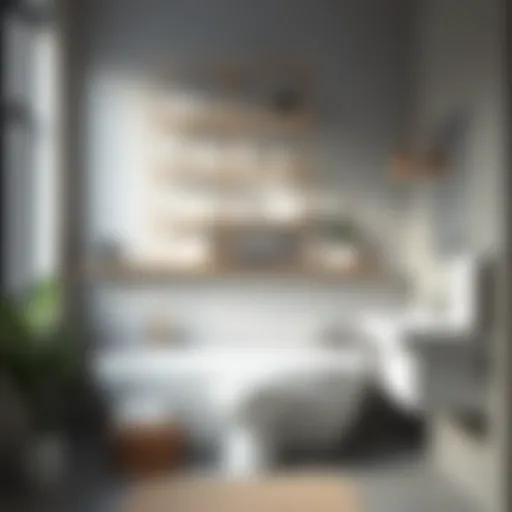Understanding Plant Grow Pots: Design and Impact


Intro
In the world of gardening and interior design, the right plant grow pots can make a world of difference. Whether you're a commercial designer embellishing a restaurant with verdant greenery or a homeowner looking to fill your living room with life, the choices you make in selecting grow pots can influence the health of your plants and the overall aesthetic of your space.
It’s often said that you can never judge a book by its cover, but when it comes to plant pots, the appearance and design are crucial. A pot can either enhance or detract from the natural beauty of the plant within it.
Understanding the materials, sizes, and drainage solutions is essential for making informed decisions.
Design Trends
Contemporary Styles
Today’s plant grow pots offer a variety of eye-catching designs reflecting contemporary tastes. From sleek geometric shapes to rustic, artisanal finishes, the options seem to be boundless. Designers are now merging traditional craftsmanship with modern aesthetics. For instance, concrete pots can achieve that urban, minimalistic vibe for your home. They are heavyweight, durable, and provide excellent insulation for plant roots.
On the other hand, ceramic pots with intricate glazes add a splash of color and personality to an otherwise mundane space. Designs that incorporate biophilic elements, like pots that mimic natural forms, have also gained traction among architects and designers looking to bring nature indoors.
Ward off the ordinary by experimenting with asymmetrical shapes and textures; they can draw the eye and lend a unique appeal to any room.
Color Palettes and Materials
Choosing the right color palette for your pots isn't just about aesthetics but also about how they integrate with your overall design scheme. Neutral tones like whites, grays, and earth colors present an elegant backdrop for vibrant plants. In contrast, bold colors can either harmonize with or starkly contrast the plant's natural hues, making them pop significantly.
Different materials have unique visual and functional attributes:
- Plastic: Lightweight and usually cost-effective. They come in various colors and can mimic the look of ceramic or metal.
- Terracotta: Traditional and porous, allowing air exchange. It’s a fabulous option for drainage but requires more care.
- Metal: Provides a modern feel and can be quite durable, though it might heat up in the sun, potentially harming your plants.
Understanding your design needs and the appropriate materials can elevate your space significantly. As environmental considerations ripple through every industry, opting for biodegradable or recycled materials when selecting pots is becoming increasingly populer. This choice not only makes a statement but also contributes to the larger conversation about sustainability in both gardening and design.
Prologue to Plant Grow Pots
In the realm of horticulture and interior design, the choice of a plant grow pot is more than a mere accessory; it’s a vital component that influences the growth and health of plants. The right pot can dramatically affect not just the aesthetic appeal of a space, but also the biological processes that sustain plant life. By understanding the nuances of plant grow pots, one can create environments where plants can thrive, which is particularly relevant for interior designers, architects, and retailers who seek to enhance the living experience within spaces.
The mere existence of a pot is often taken for granted, yet its functionality extends far beyond mere containment of soil. There are various factors to consider, such as material, size, drainage, and insulation properties. Each aspect plays a pivotal role in supporting root systems, retaining moisture, and providing a healthy ecosystem for plants.
Moreover, in a world increasingly focused on sustainability, pot selection is now intertwined with environmental consciousness. Designers must navigate through materials that echo their commitment to sustainability while still meeting the functional demands of plant care.
The following sections will unfold the essential characteristics, historical context, and types of plant grow pots, providing a comprehensive guide to making informed choices in any setting.
Defining Plant Grow Pots
Plant grow pots are containers used specifically for cultivating plants. Unlike decorative vases, these pots are designed with features that cater to the needs of living organisms. Commonly made from various materials — including clay, plastic, and metal — these pots serve to hold soil and provide the necessary environment for root formation and nutrient absorption.
It’s crucial to recognize that not all pots are created equal. Each material brings its unique advantages and disadvantages. Clay pots, for instance, offer excellent breathability but may dry out quicker than plastic ones, which retain moisture better. The size and shape of a pot also influence how well a plant can develop and thrive.
Plant grow pots take many forms, designed to accommodate different plant species and care requirements, making it imperative to choose wisely based on the intended plants and aesthetic goals.
History of Plant Pots
The history of plant pots is as rich and varied as the plants they hold. Ancient civilizations, from the Egyptians to the Chinese, modified natural materials to create earthy containers for their herbs and flowers. Terracotta pots, a staple in modern gardening, have their origins in ancient Mesopotamia, believed to date back thousands of years.
In the Renaissance, the artistry of pot design blossomed, often reflecting the cultural aesthetics of the time. Initially functional, pots began to serve as decorative pieces, especially in aristocratic gardens.
Fast forward to the 20th century, advancements in materials gave rise to plastic pots, which transformed gardening practices. Light, affordable and diverse, these pots allowed for mass gardening and increased accessibility to plant care.
Over the years, the evolution of plant pots mirrors societal changes in agricultural practices, design trends, and environmental consciousness. Today, we see a merger of traditional and modern values, as contemporary designers look to combine functionality with sustainability, making choices that echo both history and the future of gardening.
Types of Plant Grow Pots
The variety of plant grow pots available plays a crucial role in both gardening and interior design. Selecting the suitable type can vastly impact plant health, aesthetics, and ease of care. Each type serves distinct purposes and has its own pros and cons, which are essential considerations whether one is nurturing a houseplant or designing a large-scale urban garden. This section dissects the multifaceted aspects of various plant pot types, enabling informed decisions for different applications.
Material-Based Classification
Clay Pots
Clay pots have been a staple in gardening for centuries. They’re often favored for their natural aesthetic that oozes rustic charm. The principal characteristic of clay pots is their porous nature, which allows air and moisture to penetrate, aiding in root health. This unique feature offers plants better breathing space and prevents overwatering, thus appealing to many garden enthusiasts.
However, clay pots come with their own set of disadvantages. They can be hefty, making mobility a challenge. In addition, when subjected to extreme weather conditions, they might crack, requiring the gardener to invest in new pots regularly. All in all, clay pots stand as a popular yet nuanced choice for plant enthusiasts.
Plastic Pots
Plastic pots are the unsung heroes of the plant pot world. Lightweight and durable, their main appeal lies in their affordability and versatility. Gardeners can find them in various colors, shapes, and sizes, matching aesthetic desires while supporting cost-effective horticulture. The primary feature is their resistance to shattering, making them perfect for transport.
Yet, plastic pots are often criticized for lacking breathability, which could lead to root rot due to moisture build-up. This specific aspect creates an interesting consideration—while they are easy on the wallet, careful monitoring of watering levels becomes more crucial. However, their longstanding popularity can’t be understated, especially for indoor gardening.
Metal Pots


Metal pots offer a sleek and modern aesthetic that appeals to contemporary design preferences. Typically made from aluminum or stainless steel, their resilience against the elements is a significant advantage. They do an excellent job of retaining heat, which can be beneficial for certain plant species that thrive in warmer conditions.
On the flip side, they often have poor insulation properties, and without proper lining or insulation, the roots can get too hot in direct sunlight, leading to stress in the plant. Metal pots also tend to be heavier and could rust over time if not properly cared for. Although they present a risk, the visual appeal can be a significant draw for interior designers.
Biodegradable Pots
In the realm of sustainable gardening, biodegradable pots are steadily gaining ground. Made from materials like coconut coir, recycled paper, or plant fibers, they offer an eco-friendly solution to pot usage. The key characteristic here is that they can decompose naturally, eliminating waste concerns while enriching the soil.
However, one needs to consider that biodegradable pots might not retain moisture as effectively as other materials, requiring more frequent watering. In addition, they usually have a shorter lifespan compared to traditional pots. Thus, they are a beneficial, albeit temporary, fix for the environmentally conscious gardener.
Size and Shape Variations
Standard Sizes
Standard sizes of plant pots are designed with conveniently interchangeable dimensions that cater to a wide range of plant species. This consistency simplifies the process for gardeners, allowing them to easily estimate space requirements and plant growth. Their popularity comes from the ease of locating these sizes at any garden center; they are a great all-round solution.
However, using standard sizes may limit creativity and the potential for unique arrangements. While most plants will thrive in these typical dimensions, specific species can benefit from a more tailored approach.
Custom Shapes
For those who seek to break free from the mundane, custom shapes can elevate the art of gardening to new levels. These uniquely designed pots can complement the interior decor, aligning with the stylistic vision of an overall space. The distinctive appearance makes them a prominent choice among interior designers.
Nevertheless, custom shapes often come with a higher price tag, and careful planning is required regarding plant and root compatibility. Finding the right balance between aesthetic appeal and functionality can be a challenging endeavor for a gardener.
Stackable Pots
Stackable pots are clever little innovations that can maximize vertical space while minimizing the footprint. They appeal to urban gardeners with limited square footage, allowing individuals to grow a significant number of plants without overcrowding their space.
Despite their benefits, stackable pots require meticulous consideration regarding drainage and root health. Ensuring that each tier has proper moisture retention without leading to saturation can be tricky. However, many find the growth opportunity they provide worth the effort.
Specialized Pots
Self-Watering Pots
Self-watering pots are designed to harbor a reservoir of water, offering a more consistent moisture level for the plants. This kind of pot alleviates the stress of frequent watering, promoting a healthier environment for the plant’s growth. For busy individuals or those with a tendency to forget watering schedules, these pots bring ease and peace of mind.
On the downside, they can still lead to overwatering if not monitored properly, and cleaning the reservoir can sometimes be an afterthought for many. Still, their popularity is undeniable as they cater well to modern, fast-paced lifestyles.
Hanging Pots
Hanging pots have long been a favorite choice for decorators and gardeners alike. They allow for creative vertical displays and help save space while adding a dynamic floral element to any room. One important aspect of hanging pots is their ability to catch sunlight from various angles, which benefits the plants’ growth noticeably.
However, they might require more care regarding moisture, as they can dry out quickly. The challenge increases if they are positioned in breezy areas, where rapid evaporation can lead to stressed plants. Despite the caution needed, they remain a cherished choice in many homes.
Vertical Garden Systems
Vertical garden systems have surged in popularity as urban living spaces become tighter. These pots are tailored to create lush greenery in an upward fashion, perfect for growing herbs, flowers, or small vegetables. Their innovative design not only saves horizontal space but also contributes to improved air quality within enclosed areas.
Yet, the maintenance level can increase significantly. Depending on the design, watering may need more frequency to ensure that all plants receive adequate nutrients. Nevertheless, they present exciting opportunities for gardening enthusiasts eager to explore new formats.
In summary, understanding the various types of plant grow pots is fundamental for both novice and professional gardeners. It allows them to make educated decisions that align with their gardening goals, environmental considerations, and design aesthetics.
Factors Influencing Pot Choice
Choosing the right plant pot isn’t just a matter of picking something that looks nice. It's a critical aspect that can significantly influence plant health and growth. There are several factors to consider, including what type of plant you’re working with, the environmental conditions it will face, and your own aesthetic preferences. Each of these elements plays a part in ensuring the optimal conditions for your greenery.
Plant Species Requirements
Each plant has its own set of needs. Some thrive in well-drained soil, while others prefer a more moisture-retentive environment. For instance, succulents and cacti often require pots with excellent drainage to avoid root rot, making terracotta or clay pots a go-to choice. On the flip side, tropical plants like ferns might enjoy a pot that helps retain some moisture.
- Drainage Holes: A fundamental requirement. Without proper drainage, excess water can build up, leading to root suffocation.
- Size Matters: Young plants often need smaller pots that allow their roots to establish themselves. However, as they grow, they might require a larger pot to accommodate the expanding root system.
The choice of pot can initially seem trivial, but for the specific demands of plant species, it's a matter of life and death. A good gardener understands that matching the pot choice with the plant’s needs is paramount.
Environmental Conditions
Environmental factors such as humidity, temperature, and light all play integral roles in selecting the right pot. If your pot is going indoors, consider the amount of natural light that will reach it. An outdoor pot might need to account for wind and sun exposure.
- Temperature Regulation: Different materials react uniquely to changes in temperature. For instance, plastic pots do not insulate as well as earthenware pots, which can lead to overheating in direct sunlight.
- Humidity Levels: In areas with high humidity, a pot that doesn’t absorb moisture, like metal, may be suitable. But in dry climates, pots that hold some moisture could be more beneficial, helping to keep the soil hydrated.
"Understanding the interaction between a pot's material and the environmental conditions not only helps maintain plant health but also enhances their aesthetic appeal in a space."
Aesthetic Considerations
A significant part of choosing a plant pot lies in its visual appeal. After all, plants don’t just grow—they create space and ambiance. The design of the pot should harmonize with the surrounding décor, which can range from sleek metallic finishes for modern spaces to rustic clay for more traditional settings.


- Color and Texture: Bright colors can make a statement in a minimalist environment, while neutral colors might serve better in busy spaces. Texture also adds depth; think of a smooth ceramic vs. a rough burlap.
- Design Trends: Nowadays, some folks are leaning towards upcycled and repurposed materials. Unique pots can add a quirky aspect to your space, while maintaining sustainability.
The consideration of aesthetics shouldn’t overshadow functional aspects, but they sure can complement each other beautifully. A well-chosen pot enhances both the plant’s health and the visual dynamics of the room.
Choosing the right pot isn't just about practicalities; it's about creating a balance between function, environment, and beauty that resonates with your surroundings. Taking the time to evaluate these factors will lead to healthier plants and a more harmonious space.
Pot Design and Functionality
In the intricate dance of horticulture and interior design, the design and functionality of plant grow pots play a pivotal role. Choosing the right pot goes beyond mere aesthetics; it encompasses essential elements like drainage, insulation, and mobility, which can significantly affect plant health. Understanding these features is crucial for both plant enthusiasts and professionals in the industry.
Drainage Mechanisms
At the heart of any good pot design is its drainage capability. Drainage mechanisms are vital to plant health because they prevent root rot and ensure oxygen reaches the roots. Without adequate drainage, excess water can lead to a host of problems, including stagnant growth and fungal diseases.
Some pots come equipped with drainage holes that allow water to escape easily, while others incorporate specialized systems, like perforations along the sides or bottoms that facilitate greater water flow. Additionally, some modern pots utilize wicking materials or even built-in reservoirs to balance moisture levels, providing a controlled environment that many plants thrive in.
When selecting pots, consider factors like soil type and plant species. For example, cacti and succulents benefit from pots with larger drainage holes since they prefer drier conditions. On the flip side, herbs might thrive in pots with smaller holes. The compatibility of the drainage mechanism with the plants being housed is the crux of pot functionality.
Insulation Properties
Insulation properties of a pot can greatly affect a plant's growth. Insulation refers to a pot's ability to regulate the temperature of the soil and roots, which is especially important for delicate plants. Certain materials, such as terracotta and ceramic, offer superior insulation but can be quite heavy. On the other hand, plastic pots are lightweight and often have less insulating ability.
The thermal mass of a pot can either retain warmth during cooler seasons or cool down during hot weather. For instance, a pot made of thick clay keeps roots warmer in winter, fostering growth even in freezing conditions. Conversely, a pot with excellent insulating properties can prevent roots from overheating during scorching summers.
Understanding these dynamics informs better choices in pot materials based on local climates and the specific needs of the plants. Knowing which materials help regulate temperature can be a game-changer in maintaining an environmentally optimal habitat for plants.
Mobility Features
Last but not least, the mobility features of plant pots cannot be overlooked. As people often redecorate or relocate their plants based on seasonal changes, having mobile pots adds great flexibility. Pots fitted with wheels or handles wear convenience like a badge of honor.
Lightweight materials allow for easy lifting, but for larger, heavier pots, incorporating wheeled bases can save a gardener’s back. Furthermore, stacking capabilities in certain designs offer an innovative way to arrange plants without sacrificing floor space, particularly in urban settings. This functionality allows for creative arrangements as well as easy access to plants for watering and care.
Overall, the consideration of how a pot can be moved and rearranged in various settings will directly influence plant care, aesthetics, and user experience. This aspect of pot design becomes crucial for interior designers seeking to create dynamic yet functional arrangements.
In summary, the design and functionality of plant grow pots encompass far more than appearance. Understanding drainage, insulation, and mobility can lead to a healthier plant environment, enhancing both form and function in indoor and outdoor horticulture.
Innovations in Plant Grow Pots
In a world where gardening is increasingly intertwined with technology and sustainability, innovations in plant grow pots have taken a front seat. These enhancements not only improve the efficiency of plant cultivation but also address some pressing environmental issues. By embracing new technologies and materials, we can foster a healthier relationship between humans and nature while catering to the aesthetic preferences of interior designers and architects alike.
Smart Pot Technology
The integration of technology into plant care has birthed what we now call smart pots. These are not just pots with a chip; smart pot technology encompasses a range of features designed to assist both novice gardeners and seasoned horticulturists. Equipped with sensors that monitor humidity, temperature, and even soil nutrients, these pots can connect to smartphones via apps. When conditions deviate from optimal ranges, users receive alerts, making it easier to maintain plant health.
One standout feature of smart pots is the automated irrigation system. This capability significantly reduces the risk of over or under-watering plants, which is a common pitfall for many gardeners. For anyone designing an indoor space, these pots also serve an artistic purpose since they come in various stylish forms and colors. This convergence of decor and functionality appeals to those keen on creating visually appealing green spaces within homes and offices.
Eco-Friendly Innovations
As the world leans toward sustainable practices, eco-friendly innovations in plant grow pots shine bright. Traditional pots often contribute to landfill waste, especially those made from non-biodegradable materials. In response, manufacturers have turned to sustainable resources. One such alternative is biodegradable pots made from materials like coconut coir, recycled paper, or PLA (a biodegradable plastic). These options ensure that, once discarded, they return to the earth without leaving a harmful trace.
Furthermore, some companies are exploring upcycled materials for pot production. Items that might otherwise end up in a landfill can be transformed into functional gardening tools. This not only reduces waste but also presents unique design opportunities. For instance, using old tires or glass bottles as planting containers can add character to both outdoor and indoor spaces, giving a distinctive flair that appeals to creative designers.
3D Printing in Pot Manufacturing
The advent of 3D printing has revolutionized various industries, and plant pot manufacturing is no exception. This technology allows designers to create complex shapes and structures that were previously impossible or too costly to produce using traditional casting methods. With 3D printing, customization is at the forefront, offering landscapers and interior designers the flexibility to produce pots that perfectly match their design vision.
Besides customization, 3D printing can facilitate material efficiency. By utilizing only the necessary amount of material during the production process, waste can be minimized. Moreover, the ability to iterate quickly on designs means that manufacturers can experiment with forms and sizes tailored to specific plant needs or market demands.
In summary, innovations in plant grow pots represent a blend of functionality, aesthetic appeal, and sustainability. These developments cater to various stakeholders—from gardeners and retailers to interior designers—presenting a myriad of choices in terms of styles, technologies, and materials. As the market continues to evolve, one can expect these innovations to play an increasingly vital role in our green spaces.
Sustainable Practices in Pot Usage
As we navigate the evolving landscape of gardening and interior design, sustainable practices in pot usage become not just an option, but a necessity. With environmental concerns at the forefront of many discussions today, understanding how pot choices intersect with sustainability can greatly influence the overall health of our ecosystems.
By prioritizing eco-friendly practices, we engage in a more responsible approach to gardening, ensuring the longevity of both our plants and our environment. Here’s an in-depth look at the steps we can take.
Recycling Plant Pots
Recycling plant pots is a simple yet effective way to just make a big impact on reducing waste. Many gardeners find themselves with an overabundance of plastic pots that often end up in landfills. Instead of tossing them, consider these options:
- Return programs: Many garden centers and nurseries offer programs that accept used pots, often providing discounts on future purchases in return.
- Creative repurposing: With a little creativity, old pots can transform into decorative items or functional tools. For example, they can be used for organizing garden tools or even as unique art pieces in your home.
- Material recovery: If you can’t reuse, look for centers that specialize in recycling plastics. Many communities now have specific guidelines for recycling gardening containers.
By giving new life to old pots, you not only save materials from ending up in landfills but also inspire others through practical examples.
Composting Options


Composting is another marvelous avenue to explore when it comes to pot usage. Many biodegradable pots, like those made from materials such as coconut coir or compostable plastics, can be added directly to compost heaps after they have served their purpose.
Here are some points of consideration:
- Check the materials: Not all pots are created equal. It’s essential to verify that your pots are truly compostable. Look for certifications indicating that they break down in composting conditions.
- Include in compost bins: Once the pot is deemed suitable for composting, simply add it to your compost bin along with organic kitchen scraps. This enriches the soil while reducing waste.
- Education for others: Engaging others in composting practices can yield positive community results. Share your experiences and educate friends on how to properly compost pots.
Utilizing composting not only minimizes waste but also promotes a cycle of growth, enriching the soil from which future plants can thrive.
Sourcing from Sustainable Materials
The foundation of sustainable gardening lies in the materials we choose for our pots. Sourcing pots from sustainable materials reflects a commitment to maintaining ecological balance. Here’s what to keep in mind:
- Natural Fibers: Pots made from jute, bamboo, or other natural fibers tend to be biodegradable and less taxing on the environment. They also provide good aeration, which is particularly beneficial for root systems.
- Recycled Materials: Opting for pots made from recycled plastics helps reduce the demand for new materials. They maintain similar qualities to their non-recycled counterparts but with a greatly reduced environmental footprint.
- Local Sources: When possible, purchasing from local craftsmen not only supports local economies but reduces transportation-related carbon emissions. Look for artisans who utilize local, sustainable materials in their production processes.
"Choosing sustainable materials is not just about the pot itself, but about fostering a practice that supports a healthier planet."
By understanding and implementing sustainable practices in plant pot usage, we contribute to a greener future. It’s a small change that can lead to big transformations, benefiting both our gardens and the world beyond them. Through conscious decision-making and a commitment to sustainable gardening, we pave the way for plant health and environmental integrity.
Maintenance of Plant Grow Pots
Maintaining plant grow pots is not just brushing off dust or throwing away the old soil. It’s about ensuring that the pots function efficiently to promote healthy plant growth. Clean, well-maintained pots can make a world of difference in how effectively a plant thrives. This article focuses on two key aspects of maintenance: cleaning techniques and repair and upcycling strategies.
Cleaning Techniques
Regular cleaning of plant grow pots is essential, especially if they’ve been used repeatedly. Residue buildup can harbor pests and diseases which might derail any gardener's attempts at nurturing plants:
- Soaking Method: For terracotta pots, soaking them in warm, soapy water can help dislodge stubborn residues. Just ensure you dry them completely before reusing.
- Scrubbing: Use a soft brush or sponge to scrub the insides and outsides. Materials like plastic pots require gentler methods to avoid scratches, while clay pots may benefit from a bit of elbow grease.
- Disinfecting Solutions: A mix of one part bleach to nine parts water works wonders for disinfecting pots that previously housed contaminated plants. Rinse thoroughly to remove any residues.
- Natural Cleaners: For those leaning towards eco-friendly options, vinegar or baking soda serves as excellent natural cleaners. Mimicking an old recipe passed down, a paste of vinegar and baking soda can scrub away grime while being gentle on the pot material.
Cleaning keeps your pots in optimal condition and helps in monitoring for any cracks or structural damage that needs addressing.
Repair and Upcycling
If you've ever faced a cracked pot, you know the heartache of losing a plant. However, rather than tossing it away, consider repair and upcycling tackles:
- Filling Cracks: Use water-resistant adhesives for ceramic and clay pots. For plastic pots, a strong tape can provide short-term relief. Cracks can affect drainage, so patching them up is essential.
- Creating New Uses: Old pots can have a new life as unique garden decor. Consider transforming them into bird feeders or herb planters. Pot gardening can be used in unconventional ways. Just make sure if they're going to hold soil, there's no compromise on structural integrity.
- Painting and Decorating Pots: An old pot does not need to stay old. A fresh coat of non-toxic paint or even some fabric wraps can breathe new life into them. This not only enhances your garden’s aesthetic but also allows expression of creativity.
- Stacking Pots: For those pots with minor damage but still usable, consider stacking them for a vertical gardening solution. This enhances growth space without requiring additional materials.
"A repaired pot is often as valuable as a new one; it holds a story and adds character to your garden space."
Taking the time to maintain, clean, and even upcycle plant grow pots creates a sustainable gardening practice. It fosters a deeper connection with the plants and boosts overall plant health. A commitment to pot maintenance reflects in the vitality of the greenery it houses, ultimately supporting a beautiful, lush environment.
The Role of Pots in Plant Growth
Understanding the role of pots in plant growth encompasses much more than just the vessels where plants reside. These containers act as crucial components in a plant's life cycle, influencing several aspects of health and vitality. A well-considered pot choice can mean the difference between thriving greens and struggling seedlings.
Root Development
Roots are the unsung heroes of any plant's growth journey. The type of pot used directly affects root development. When roots have ample space, they can spread out, seeking moisture and nutrients that are vital for the plant's success. Conversely, if a pot is too small, roots may become pot-bound, curling around the edges without adequate room to grow. This leads to stunted growth and can even cause the plant to wither.
Good drainage is essential; pots with holes allow excess water to escape, preventing roots from sitting in soggy soil which can lead to root rot. In recent years, specialized pots have emerged that not only promote drainage but also aeration. For instance, the use of breathable fabric pots enables oxygen to penetrate the soil more effectively. The significance of ensuring a proper environment for root development arrives front and center.
- Container Size: A larger pot provides room for roots to thrive, while a smaller one can constrict growth.
- Drainage: Drainage holes prevent oversaturation, allowing roots to breathe and thrive.
- Material Choice: Different materials offer varying breathability and insulation properties.
Nutrient Retention
Another vital role of pots in plant growth is their capacity for nutrient retention. The soil within the pot acts as the reservoir for essential nutrients like nitrogen, phosphorus, and potassium. However, the choice of pot and soil mix can drastically affect a plant's access to these nutrients.
Using a pot that retains moisture without becoming waterlogged is crucial. For instance, clay pots are porous and allow moisture to evaporate, which can be beneficial for plants that prefer drier conditions. On the flip side, plastic pots tend to hold moisture better, thus suitable for plants that require consistent hydration.
Moreover, how a pot performs in retaining nutrients is also impacted by the potting media. A blend that includes compost or nutrient-dense soil can create a more fertile environment, ensuring plants have what they need to flourish. In addition, regular feeding with fertilizers becomes vital, especially when using smaller or single-use pots without the ability to hold nutrients for extended periods.
- Soil Mixture: The right mix can hold onto nutrients effectively.
- Pot Material: Some materials retain nutrients better than others.
- Watering Strategy: Balancing moisture levels influences nutrient uptake.
"Investing in the right pot can lead to a healthier, more robust plant. It's not just a container; it's a lifeline for growth."
Epilogue
The conclusion of an article acts like the final brushstrokes of an artist on a canvas, bringing everything into a focused perspective. In this context, it reaffirms the significant role that plant grow pots play in enhancing both horticultural practices and interior aesthetics. By thoughtfully selecting the right pot, individuals can vastly improve plant health, optimize growth, and elevate the ambiance of a space.
Recap of Key Points
- Understanding Material Variations: The varying materials—such as clay, plastic, and biodegradable options—have unique attributes that directly impact plant care and environmental sustainability. It’s important to choose pots that complement the specific needs of the plants, as well as personal or design preferences.
- Importance of Size and Shape: The right pot size and shape are crucial for encouraging strong root development and healthy plant growth. Whether opting for a tall, slender design or wide, shallow pots, each serves a different purpose that can enhance planting outcomes.
- Innovative Features: The advent of smart pots and eco-friendly designs showcases how technology and sustainability are merging. Self-watering systems, integrated sensors, and materials sourced from sustainable practices are paving the way for modern gardening, appealing to forward-thinking designers and consumers alike.
- Sustainability Practices: Recycling options and composting methods for plant pots contribute to reducing environmental impact. Understanding how to maintain pots and ensuring they last longer enhances the sustainability quotient of gardening.
- Future Considerations: Looking ahead, trends in pot design and functionality will continue to evolve. As we further integrate technology into daily life, expect plant pots that not only serve their original tasks but also cater to the aesthetic sentiments of a more design-conscious society.
As gardening continues to gain traction as a hobby and lifestyle choice, plant pots will prove to be crucial not just as tools but as integral elements of our living environments.
Future Trends in Plant Pots
Anticipating the future of plant grow pots involves looking beyond their conventional function. A few key trends emerge that could shape what’s next:
- Enhanced Smart Technology: The incorporation of sensors that track moisture levels, light exposure, and nutrient content will empower users to provide precise care for their plants. It’s not just about having a pretty pot; it's about intelligent design that actively contributes to plant health.
- Adaptable Designs: Future pots may become more versatile, featuring modular designs that allow for easy customization. This adaptability will aid in ensuring pots can be rearranged without disrupting plant life.
- Sustainable Innovations: More brands are likely to focus on eco-friendly materials. From recycled plastics to bioplastics, the emphasis will continue to shift toward reducing environmental footprints while providing quality solutions for plant owners.
- Stylish Integration: Expect styles that blend seamlessly with modern interior design trends. A fusion of functionality and artistry will ensure that plant pots serve as both containers for growth and as striking decor elements.
For further insights into eco-friendly gardening practices and innovative pot designs, visit reputable resources such as Wikipedia and Britannica. Additionally, engage with community discussions on platforms like Reddit or explore sustainable gardening initiatives on regional government websites, which often provide valuable local resources and support.















